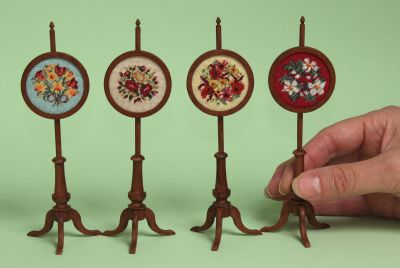How to make a dollhouse pole screen
These tutorials were originally written to help people who had bought my dollhouse needlepoint kits – they show you how to do the stitching and assemble each type of kit. In November 2024 I retired, so these pages are now a ‘legacy archive’ only. I NO LONGER SELL THESE KITS, so please do not contact me asking where you can buy them! I plan to keep these tutorials available until at least the end of 2026, so that people who bought kits but haven’t made them up yet have a while to use the tutorials to complete their kits 🙂

The pole screen measures four and three quarters of an inch high, and is made from finely-turned, high quality mahogany. The design is to be stitched in tent stitch (similar to half cross stitch) on 40 count silk gauze, using one strand of Anchor stranded cotton.
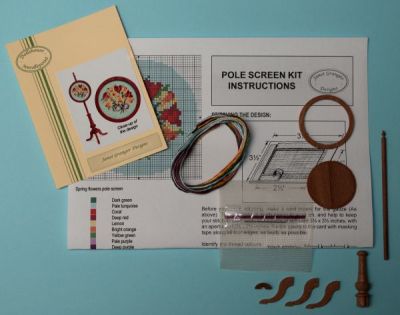
The kits contain an easy-to-assemble twelfth scale mahogany pole screen kit, along with all you need to stitch the design – a generous piece of 40 count silk gauze fabric, ample Anchor stranded cotton thread, a fine needle, colour block chart (the design is not printed on the fabric) and detailed instructions.
If you have never done miniature needlepoint before, start by reading the BASIC EQUIPMENT, NEEDLEPOINT STITCHES and COUNTING FROM A COLOUR BLOCK CHART tutorials first, then come back to this page.
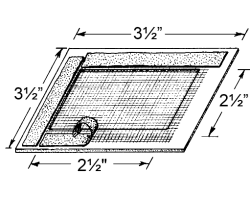 To start with, mount the silk gauze in a card mount to keep it taut (see the TUTORIAL for how to do this). Identify the thread colours using the colour key. Using tent stitch for the details and basketweave stitch for the background, as indicated in the diagrams, start the design in the centre. Remember that one square on the chart equals one stitch, and always use a ‘stabbing’ motion, not a ‘sewing’ one.
To start with, mount the silk gauze in a card mount to keep it taut (see the TUTORIAL for how to do this). Identify the thread colours using the colour key. Using tent stitch for the details and basketweave stitch for the background, as indicated in the diagrams, start the design in the centre. Remember that one square on the chart equals one stitch, and always use a ‘stabbing’ motion, not a ‘sewing’ one.
Using one strand of thread in the needle, begin each length by knotting one end and taking the needle from the front to the back of the silk gauze, about half an inch away from where you intend to start stitching. Stitch towards the knot, securing the underlying thread as you go. Snip the knot off when you reach it. Finish each length by running the needle under a few threads on the back. When the stitching is complete, press it face down over a soft pad such as a towel, using an iron on medium setting, pulling the fabric gently if necessary to get it dead square.
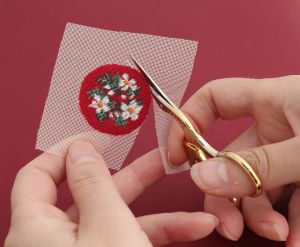
Trim the unused silk gauze off right up to the stitching, and put the stitching to one side for now, while you assemble the pole screen.
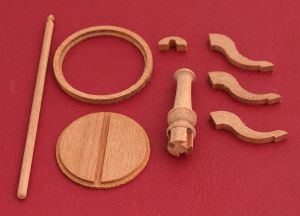
Do a ‘dry-run’ assembly first, to make sure you know how all the pieces fit together, before using wood glue. The components for the pole screen look like this:

The three legs of the pole screen need to be shaped a little, so that the legs and feet are slightly rounded – this is best achieved with coarse sandpaper. Do not round off the upper end of the leg (the part that fits into the notches on the turned central base).
Then sand all the components with fine sand paper until they are very smooth.
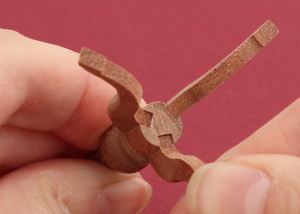
Glue the three legs in place on the turned central base, using wood glue.

I found that it helps to also glue the long pole in position at the same time, so that you can check that the feet are positioned properly, and that the central turned base will hold the pole absolutely vertical. Leave to dry thoroughly.
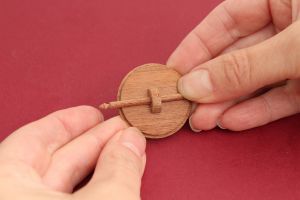
Dry fit the small frame holding lug on to the backplate. Holding it in position, slide the pole under the lug. If the frame slides too far down the pole, sand a little off the lug to make the depth of the inner curve shallower, and the fit therefore tighter. Then glue it into position on the backplate.
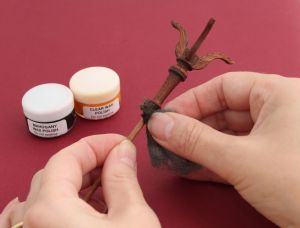
Apply the wax polish to all the pole screen parts with fine wire wool, and buff to a shine with a soft cloth. Two coats will give a good depth of colour.
The backplate has a piece of double-sided tape already positioned on the front – leave the protective cover in place over it as you wax the backplate.
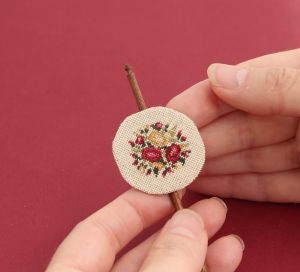
Once all the pole screen parts have been waxed, take the stitching, remove the protective cover from the double-sided tape, and position the stitching carefully on the backplate. To make sure the stitching is positioned correctly on the backplate, slide the backplate onto the pole first, and use the pole as a visual guide. Keep re-positioning the stitching over the double-sided tape until you are completely sure that it is centred, and the right way up.
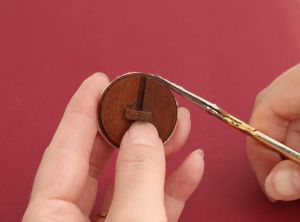
Temporarily remove the pole, and with the stitching facing away from you, and using very sharp scissors, cut away any gauze that overlaps the edge of the wooden backplate. You do not need to use a fabric glue such as Fray Check first, as any cut edges will be held down by the edge of the round frame.
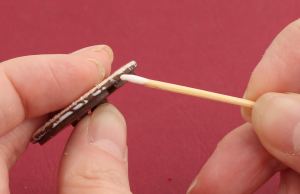
Using a toothpick or very fine brush, apply tiny dots of wood glue around the very outer edge of the wooden backplate only (not the fabric as well).
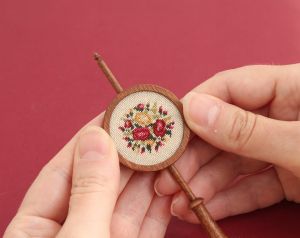
Smooth the glue out into a continous line around the edge. Slide the backplate onto the pole again, and, with the stitching facing you, gently push the round frame into position on the backplate, making sure that the grain of the frame runs vertically.
Place the frame back onto the pole and slide it into position.
Your pole screen is now finished, and ready to be placed in your doll’s house, where it will make a stunning addition!

